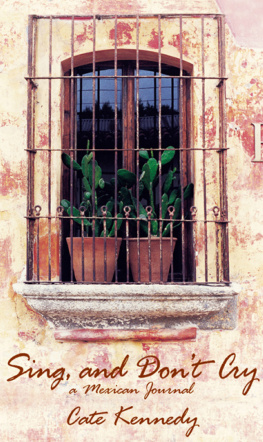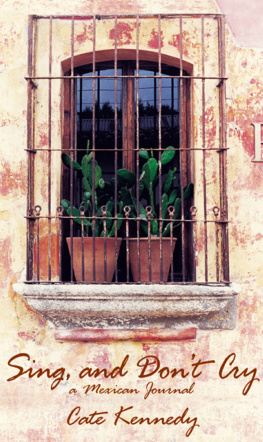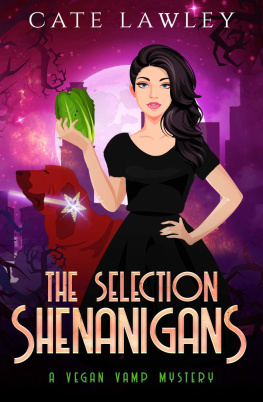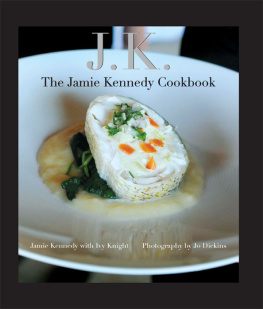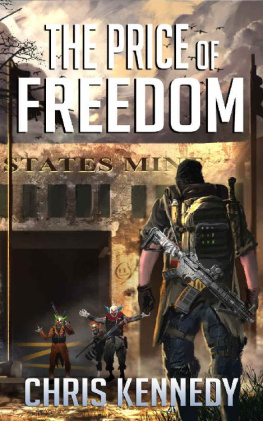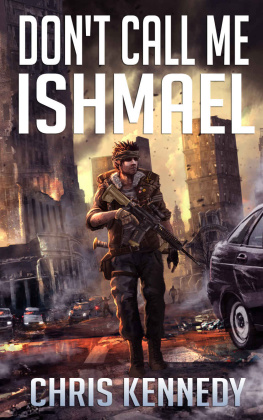First published 2005
Reprinted 2008
This revised e-book edition 2011
Transit Lounge Publishing
95 Stephen Street
Yarraville, Australia 3013
www.transitlounge.com.au
Copyright Cate Kennedy 2005
This book is copyright. Apart from any fair dealing for the purpose of private study, research, criticism or review, as permitted under the Copyright Act, no part may be reproduced by any process without written permission. Enquiries should be made to the publisher.
Cover design: Tim McQuiston
Typeset by J&M Typesetting
National Library of Australia
Cataloguing-in-publication data:
Kennedy, Cate.
Sing, and Dont Cry: a Mexican journal.
ISBN 0 9780980846256 (e-book)
1. Kennedy, Cate. 2. Mexico Social life and customs. 3. Mexico Civilization. I. Title.
972.084
B uenas dias. Buenas dias. Buenas dias, y bienvenidos.
Forty-eight work-worn hands appear from within cotton shawls to brush mine in welcome, before the women take their place patiently underneath a prickly mesquite tree beside a rubble wall sprouting cactus. People occasionally step over a tumbledown section of this wall and make their way up the steep stony road. A pack of slinking dogs appears at our arrival and they prowl around the perimeter of the group, their patchy muzzles lifted hopefully. The women hiss and make as if to throw stones, and the dogs yelp dramatically and cower away, nosing around in the shade and settling themselves a little distance away, like hyenas. The vertebrae in their skinny spines jut up under their fur like the sharp-ridged hills on the horizon.
There are two plastic chairs and I am sitting on one of them, at a plastic table. A pile of savings books grows on the desk. I can hardly speak any Spanish yet but I can add up, so Ive been given the task of calculating interest in these books. Savings: eighty pesos. Interest: fifty centavos. There are a hundred centavos to the peso, so that princely sum of interest is about seven cents Australian.
As I finish, I hand back the savings books and the women quickly, politely, check the figure and tuck the books back in their apron pockets.
Its extremely hot, but nobody is complaining. An old man hobbles by with a donkey, weighed down with two big plastic drums of water, and everybody murmurs a greeting towards him as he moves past.
Next to us is a windowless cement-block building, about five metres square. My workmate, talking to me in a fluid river of Spanish, points to it, explaining something.
Kind-air, she is repeating. Could this little place roofed in scrap iron be a kindergarten? She points down the hill, to the next town about fifteen minutes away, and from the ribbon of language issuing from her mouth I recognise one of the few words I know: escuela. School.
I cant believe my first guess could be right, though. Surely the buildings some kind of storeroom or shed. The following month, when I will find myself here again, the door to the tiny building will be pushed open and a roomful of five-year-olds will spill out, carrying their plastic chairs for a game of musical chairs on the cobbled street. Boys and girls, they will all be dressed in crisp gingham aprons over their clean, cut-down clothes. When I peek into the room, I will see that one dim, suspended globe lights the whole room. They have no music, so their teacher will stand with her back to them, clapping and stopping at random as they march around the chairs. They will be giggling their heads off.
Today is my first day working in a rural development organisation and microcredit cooperative a bank for peasant farmers and their families. Of the nine thousand members, nearly all are women and children. On the list in front of me I can just work out the names the savings groups here have given themselves: A Small Dream for the Future, Pull Together and Together We Are Strong. A sociologist would salivate seeing the cultural iconography that decorates their passbooks: pictures of the Virgin Mary alongside Michael Jordan, the Mexican flag pasted under Mickey Mouse.
It is the figures inside these savings books which make me realise Im actually here, in impoverished, struggling Latin America, and how vulnerable these people would be to debt exploitation. Most members save two or three pesos a week, collected by the cashier and presented with a long deposit slip of laboriously pencilled signatures, and up to half of those signatures are just Xs.
I look down the savings lists. Purificacin is a common name, as is Esperanza. Purification and Hope. There are children named Ezekiel and Angel, Luminosa and Maria de la Guadalupe. Ive noticed that most people, though, call their children mi vida my life. Were a bank for these people, offering them a safe place to save and access to small amounts of credit. Some people owe two thousand pesos, some five thousand, and they are doggedly paying off their debts with every centavo they can scrape together. There are particular repayment conditions for each type of loan, but basically there are five common criteria for borrowing. For people with so little, for whom the equivalent of thirty dollars is a fortune, you know those five criteria are going to represent in microcosm the perceived necessities of life, its catastrophes as well as its small dreams for the future.
At this, my first meeting, someone proudly tells me what these criteria are. You can borrow money to purchase medicines and emergency medical care if somebody is sick or having a baby. You can borrow money for animals, or fencing wire, or roofing iron, or concrete blocks, or anything that can be deemed home improvements which help sustain you in terms of providing for yourself. You can borrow for school supplies and expenses involved with getting your kids an education. You can borrow money for fiestas, for the things you need to celebrate feast days, weddings, christenings and so on. And lastly you can borrow money to walk, in a special peregrinacin with the other faithful, to distant shrines and cathedrals associated with special holy days. These are the five things considered essential for life and worth getting into debt for: medicine, education, home improvements, fiestas and pilgrimages.
I smile when I hear the last two, and that is my first error in understanding. I am newly arrived, so I dont see yet how a fiesta could be as crucial as education, or a pilgrimage as necessary as medicine. This is a currency I still have to learn, sitting at that dusty card table adding up pesos. When I do, I will get a glimmer, from these resilient and patient people, of what is truly essential, and who is truly poor.

